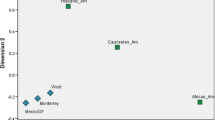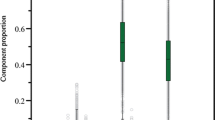Summary
The HLA DQa amplification and typing kit has been designed to be used by the forensic community for purposes of identity testing. The introduction of any new DNA marker in forensic identity testing requires the establishment of a population database for the relevant population(s) [1]. To this end allele and genotype frequencies for the HLADQα locus were determined in a Dutch Caucasian population sample and compared with 7 other population genetic studies. In our population sample the HLA DQα genotype frequencies did not deviate from Hardy-Weinberg expectations and for this locus the power of discrimination is 0.94. A test for homogeneity of the HLA DQα population data based on the allele frequency counts for 8 Caucasian population samples was performed and significant differences were found (P = 0.007) . The differences in the frequency of the HLADQα 2 and 3 alleles are the major cause of this deviation. No deviation from population homogeneity was observed when we compared thegenotype frequency distributions among the 8 Caucasian population samples. Combined with the extensive validation studies from Comey and Budowle [7] and Helmuth et al. [8] this population genetic study will allow HLADQα typing to be used in forensic identity testing in the Netherlands.
Zusammenfassung
Der Kit für die Amplifikation und Typisierung von HLA DQa wurde als geeignet erklärt für Identitätstests. Die Einführung jedes neuen DNA-Markersystems in forensischen Identitätsuntersuchungen erfordert die Etablierung einer Datenbank für die relevante(n) Population(en) [1]. Mit dieser Zielsetzung wurden Allel- und Genotypfrequenzen in einer holländisehen Kaukasier-Stichprobe untersucht und mit 7 anderen populationsgenetischen Studien verglichen. In unserer Populationsstichprobe wichen die HLADQα-Genotypfrequenzen nicht von Hardy-Weinberg-Erwartungen ab; und für diesen Locus beträgt die Diskriminations-Kraft 0.94. Eine Untersuchung auf Homogenität der HLADQα-Populationsdaten, basierend auf den Allel-frequenzen für 8 kaukasische Populationsstichproben, wurde durchgeführt und es fanden sich signifikante Unterschiede (P = 0.007). Die Differenzen in der Frequenz der Allele HLADQα 2 und 3 sind die wesentliche Ursache dieser Abweichung. Keine Abweichung von der Homogenität wurde beobachtet, wenn wir die Genotyp-Frequenzverteilungen zwischen den 8 kaukasischen Populationsstichproben verglichen. In Kombination mit den extensiven Validierungsstudien von Comey und Budowle [7] und Helmuth et al. [8] erlaubt die vorliegende populationsgenetische Studie die Typisierung von HLA DQα bei forensischen Identitätsuntersuchungen in den Niederlanden.
Similar content being viewed by others
References
DNA commission of the International Society for Forensic Haemogenetics (1992) Second DNA recommendations. Int J Leg Med 104:361–364
Higuchi R, von Beroldingen CH, Sensabough GF, Erlich HA (1988) DNA typing from single hairs. Nature 332:543–546
von Beroldingen CH, Blake ET, Higuchi R, Sensabaugh GF, Erlich HA (1989) Applications of PCR to the analysis of biological evidence. In: Erlich HA (ed) PCR Technology, principles and applications for DNA Amplification. Stockton Press. Chapter 17.
Saiki RK, Walsh PS, Levenson CH, Erlich HA (1989) Genetic analysis of amplified DNA with immobilized sequence-specific olignucleotide probes. Proc Natl Acad Sci USA 86:6230–6234
Bugawan TL, Saiki RK, Levenson CH, Watson RM, Erlich HA (1988) The use of non-radioactive oligonucleotide probes to analyze enzymatically amplified DNA for prenatal diagnosis and forensic HLA typing. Biotechnology 6:943–947
AmplitypeTM User Guide — Version 2 (1990) Cetus Corporation, Emmeryville, CA, USA
Comey CT, Budowle B (1991) Validation studies on the analysis of the HLADQα locus using the polymerase chain reaction. J Forensic Sci 36:1633–1648
Helmuth R, Fildes N, Blake E, Luce MC, Chimera J, Madej R, Gorodezky C, Stoneking M, Schmill N, Klitz W, Higuchi R, Erlich HA (1990) HLADQα allele and genotype frequencies in various human populations, determined by using enzymatic amplification and oligonucleotide probes. Am J Hum Genet 47:515–523
Schneider PM, Prager-Eberle M, Rittner C (1991) Zur Anwendung der Polymerase Kettenreaktion (PCR) des HLADQαSystems in der forensischen Spurenkunde. Arch Kriminol 188:167–174
Sullivan KM, Gill P, Lingard D, Lygo JE (1992) Characterization of HLADQα for forensic purposes. Allele and genotype frequencies in British Caucasian, Afro-Caribbean and Asian populations. Int J Leg Med 105:17–20
Sajantila A, Ström M, Budowle B, Tienari PJ, Ehnholm C, Peltonen L (1991) The distribution of the HLADQα alleles and genotypes in the Finnish population as determined by the use of DNA amplification and allele specific oligonucleotides. Int J Leg Med 104:181–184
Harrington CS, Dunaiski V, Williams K, Fowler C (1991) HLADQα typing of forensic specimens by amplification restriction fragment polymorphism (ARFP) analysis. Forensic SciInt 51:147–157
Budowle B, Sajantilla A, Hochmeister MN, Comey CT (1992) The application of PCR to forensic science. In: Ferre F, Mullis K and Gibbs R (eds). The Polymerase chain reaction. Birkhauer Verlag, Basel (in press)
Lorente JA, Lorente M, Budowle B, Comey CT, Villanueva E (1992) HLADQα types in the Spanish population. Proceedings of Promega 1992 International Symposium on Human Identification. Scottsdale, Ariz, USA
Jung JM, Comey CT, Bear DB, Budowle B (1991) Extraction strategy for obtaining DNA from bloodstains for PCR amplification and typing of the HLADQα gene. Int J Leg Med 104:145–148
Waye JS, Presley LA, Budowle B, Shutler GG, Fourney RM (1990) A simple and sensitive method for quantifying human genomic DNA in forensic specimen extracts. Biotechniques 7:852–855
Documenta Geigy; Wissenschaftliche Tabellen; 7th edn (1968). Geigy Basel, pp 85-103
Nei M, Roychoudhury AK (1974) Sampling variances of heterozygosity and genetic distance. Genetics 76:379–390
Piazza A, Menozzi P, Cavalli-Sforza LL (1980) The HLA-A,B gene frequencies in the world: migration or selection? Hum Immunol 1:297–304
Roff DA, Bentzen P (1989) The statistical analysis of mitochondrial DNA-polymorphisms and the problem of small samples. Mol Biol Evol 6:539–545
Author information
Authors and Affiliations
Rights and permissions
About this article
Cite this article
Kloosterman, A.D., Budowe, B. & Riley, E.L. Population data of the HLA DQα locus in Dutch caucasians. Int J Leg Med 105, 233–238 (1993). https://doi.org/10.1007/BF01642800
Received:
Revised:
Issue Date:
DOI: https://doi.org/10.1007/BF01642800




